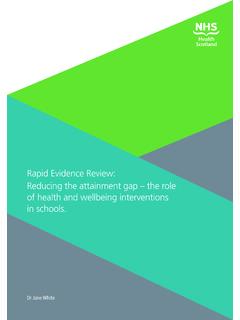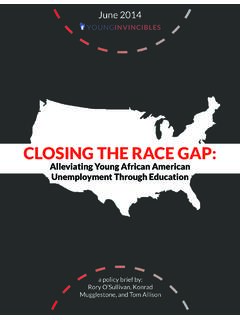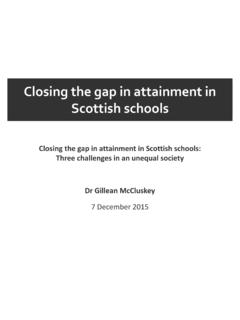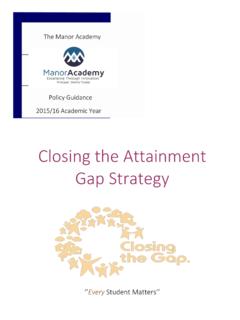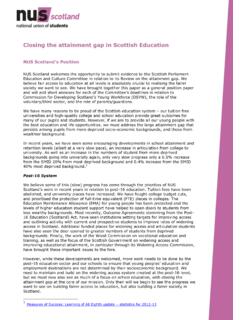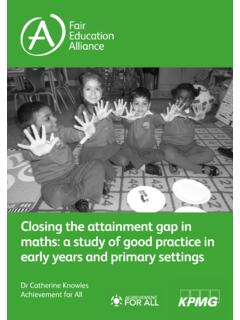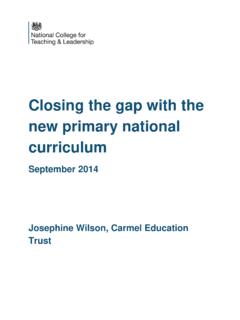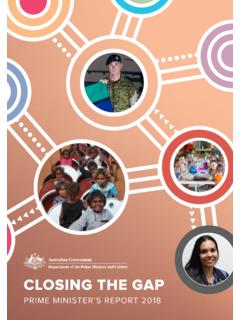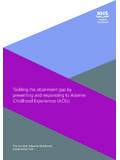Transcription of CLOSING THE GAP: STRATEGIES FOR INCREASING HIGHER ...
1 1 POLICY REPORT JUNE 2017 Executive Summary Despite recent gains, the high school graduation rate in Nevada continues to be one of the lowest in the nation and falls well below the national average. In addition, enrollment in post-secondary education and college attainment rates continue to lag in the Silver State. These are troubling statistics given that by 2020, 49 percent of jobs in Nevada will require some sort of post-secondary degree or certificate, but less than a four-year degree ( middle skilled jobs ).
2 Researchers and policy experts around the country have argued that the rising costs of HIGHER education are among the greatest obstacles facing individuals who are interested in HIGHER education. In the Silver State, registration fees at community colleges rose 93 percent over the period 2002-2003 to 2015-2016. In recent years, the federal government, as well as many state governments and systems of HIGHER education have implemented programs designed to increase the college-going and HIGHER education attainment rates, and address the issue of college affordability.
3 One of the more popular initiatives is the government sponsored program to pay tuition and fees for students who enroll in community college. These initiatives, known as Promise programs, vary in requirements but all have the same goal of reducing student loan debt and encouraging college enrollment and completion. During the 79th Legislative Session, the Nevada Legislature passed a Nevada Promise program (Senate Bill 391), which will launch in Fall 2017. The Nevada Promise program, as described in Senate Bill 391, has the following principal characteristics: Last-dollar scholarship, covering tuition and fees, not covered by federal (Pell) grants and state financial aid ( , Silver State Opportunity Grant, Millennium Scholarship).
4 Eligible students must be a resident of the state, must not have reached 20 years of age, and must not have previously been awarded an associate s degree or bachelor s degree. Students must complete and submit Free Application for Federal Student Aid (FAFSA) by April 1. Student must have obtained a high school diploma from a high school in Nevada. Student must be enrolled in at least 12 semester credit hours in an associate s degree program, a bachelor s degree program, or a certificate of achievement program at a community college for each semester of the school year immediately following the school year in which the student was awarded a high school diploma.
5 To retain the scholarship, student must maintain a grade point average. Students must complete at least hours of 20 hours of community service. Research reveals that Promise programs have achieved success in reducing student debt loads and INCREASING the college-going rates and education attainment levels of young adults. Below is a summary of the impact of these programs: Improved K-12 test scores, HIGHER graduation rates and lower drop-out rates HIGHER student grade point averages (GPAs) and improved student behavior An increase in the number of first-time freshman HIGHER retention (persistence) rates in college, and HIGHER numbers of high school graduates earning post-secondary credentials within 6 years of graduation.
6 CLOSING THE GAP: STRATEGIES FOR INCREASING HIGHER EDUCATION attainment IN NEVADA 2 POLICY REPORT JUNE 2017 Introduction Despite recent gains, the high school graduation rate in Nevada continues to be one of the lowest in the nation and falls well below the national The Department of Education reported that the national high school graduation rate for the 2014-2015 cohort was percent, compared to only percent in In addition, enrollment in post-secondary education and college attainment rates (the percentage of Nevadans with a HIGHER education degree) continue to lag in the Silver State.
7 In fact, college attainment is well below the national average. Less than one-third (31 percent) of our Silver State s population (age 25-64) has an Associate s This is a troubling statistic given that by 2020, 49 percent of jobs in Nevada will require some sort of post-secondary degree or certificate, but less than a four-year degree ( middle skilled jobs ). As noted by Dr. Steve Canavero, Superintendent of Instruction of Nevada Department of Education, Middle skilled jobs are the majority of the in-demand occupations and those without a high school diploma are excluded from 90 percent of the in-demand occupations.
8 4 Researchers and policy experts around the country have argued that the rising costs of HIGHER education are among the greatest obstacles facing individuals who are interested in HIGHER In the Silver State, registration fees at community colleges rose 93 percent over the period 2002-2003 to In recent years, the federal government, as well as many state governments and systems of HIGHER education have implemented several programs designed to increase the college going and HIGHER education attainment rates, and address the issue of college affordability.
9 One of the more well-known initiatives is the government-sponsored program to pay tuition and fees for students who enroll in community college. These initiatives, known as Promise programs, vary in requirements but all have the same goal of reducing student loan debt and encouraging college enrollment and completion. During the 79th Legislative Session, the Nevada Legislature passed a Nevada Promise program (Senate Bill 391), which will launch in Fall Preliminary research indicates that Promise programs have had their intended impact.
10 In states where Promise programs exist, student debt loads have fallen, college going rates have increased, and college retention (persistence) rates have increased. This policy report presents data on HIGHER education attainment in Nevada, surveys the potential need for a Promise program in Nevada, reviews a selection of Promise programs around the country, summarizes recent legislation to launch a Promise program in Nevada, and describes the impact of said programs around the country.
